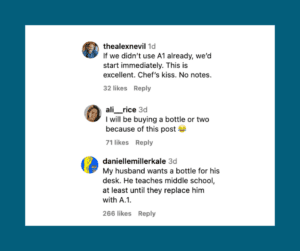Sometimes the internet just gives you moments – and the brands that know how to respond? They win.
Two of the best brand responses on social media in 2025 happened in the last week alone. In a chaotic and crowded social media landscape, A.1. Steak Sauce and Nike reminded us how powerful real-time marketing can be.
Real-Time Marketing Example 1: A.1. Steals the Spotlight
Let’s start with A1. Earlier this month, former WWE executive and U.S. Secretary of Education Linda McMahon made a blunder during a speech about education innovation, apparently confusing artificial intelligence (AI) with A.1., the steak sauce:
“A school system that’s going to start making sure that first graders, or even pre-Ks, have A.1. teaching in every year. That’s a wonderful thing!”
To be fair, McMahon had referred to AI by its correct acronym earlier in the speech, but then she doubled down:
“Kids are sponges. They just absorb everything. It wasn’t all that long ago that it was, ‘We’re going to have internet in our schools!’ Now let’s see A.1. and how can that be helpful.”
A.1. saw the opportunity and went for it with one of the funniest, most well-timed brand reactions to a viral moment in recent history. It was a masterclass on how brands can go viral on social by simply being fast, self-aware, and human:
View this post on Instagram
Fans lapped it up, heaping on the comments:
This was clearly a clever and funny response to a newsy moment, but we give extra props to A1 for wading in even though the subtext of the story was political. For many brands, that’s a no-no, especially in this viral meme format. A.1. dared to respond anyway, eliciting chuckles that crossed party lines.
Real-Time Marketing Example 2: Nike’s Rory Reaction
Just days later, Nike’s real-time marketing win came in the form of a sleek, high-production Reel just waiting to be trotted out at the right moment: celebrating Rory McIlroy’s career Grand Slam after winning the 2025 Masters Tournament.
View this post on Instagram
The end slide, the caption, the speed at which Nike pushed this out on Sunday night– pure marketing genius. This wasn’t a scheduled post. It was a “we were waiting for this, and we’re ready” moment that landed.
No over-explaining. No waiting until Monday to publish. Nike reminded us they don’t just sponsor athletes. They celebrate their stories as they happen.
Why These Brands Won Social (and the Internet)
Both A.1. and Nike succeeded not just because they had something to say, but because they said it at the right time. They tapped into viral moments that people were already talking about, proving again why brands reacting to trending conversations stand out among static, scheduled content.
This kind of reactive social media marketing isn’t reserved for massive teams or billion-dollar corporations. It’s about listening, responding quickly, and leaning into what’s happening right now – whether it’s a slip of the tongue or a historic sports victory.
How Brands Can Capitalize on Trending Moments
Whether you’re a pantry staple or a global sports giant (or, more likely, somewhere in between), there’s a playbook here:
- Monitor the culture. Stay tuned into what’s trending.
- Move quickly. Don’t wait days for the perfect creative. As A.1. showed us, relevance beats polish.
- On the flip side – if your brand revolves around certain events, take the time beforehand to queue up a strong piece of creative like Nike did. Then push it out at the right moment.
- Be bold. Audiences love it when brands take risks and act human.
So the next time the internet hands you a moment, ask yourself: What would A.1. do? What would Nike do?
And then, to borrow Nike’s famous slogan: Just do it.
Interested in putting these lessons to work, but not sure where to start? We offer custom social media management solutions to help you get a handle on your strategy. Contact us to get started!


